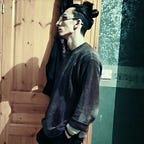Back when I started writing on tensors[†, ‡], I had an idea. I wanted to cast the constraints founds in regular language to a geometric format.
The backbone of that thought is a long-held belief that meaning takes shape from utter chaotic freedom by imposition of order through limitation and constraints. Expression has form and thus geometry.
Even though one can rule such idea as an aesthetical pursuit, its realization seemed more and more plausible as I exposed my thoughts on knowledge[††, ‡‡, †‡] and elaborated on certain key constructs which as you will see — in this essay — play a key role.
The ideal of this work is to attain, unity in expression.
The aspects and properties of knowables — objects of knowledge — split into Quantities and Qualities. To write about each, we employ two different languages.
Quantifiable aspects are things we can put in numbers and express their dynamic via equations and inequalities. Suitable for precise treatment, the language we developed for such case is, Mathematics.
Qualitative aspects do not do well with numbers, leaving us with the only option to put in them in words and express their rules as principles. Treatment of “un-quantifiables” is done primarily in plain language, with at times, a specialized vocabulary.
The “language of quantity” dominates science due its predictive power and the level of control that comes with it. It is THE language of the era and a lot of effort has been put into its development.
Its success incentivized many to continuously look for ways to expand its scope of application to fields which previously resisted its usage. Yet instead of riding this “mathematization” wave, I stand here with a different thesis.
There is a higher language to both quantity and quality where both are simply a differentiation of it.
Things, in general, are partly described via quantities and partly via qualities. Take a person as an example. There are things we can measure about such person like, weight, height, temperature and blood pressure. Yet there are others things we can’t put a number on so we just label them as a quality like being aware, happy, cheerful, judgmental and sad.
The purpose of previous essays was to seek a perspective in which quantities and qualities employ the same language. Finding such mode of expression implies the existence of a mapping which can be used to import techniques from one sector to another‡†.
I made it clear that I regard tensors as fundamental objects in the “Linguistics of Quantity”; where laws take the form of equations and inequalities, that is, constraints between tensors. And where, calculus is merely the successive application of constraints on tensor expressions — in other words, descriptions — to cast them in a form that emphasizes the quantities of interest.
Based on the possibility — which I shall demonstrate below — of expressing core structures to both quantitative and qualitative language via unifying concepts. I define the notion of a conceptor, as the analog of a tensor in the qualitative sector.
Principles and conditions — which represent qualitative laws — are analog to equations and inequalities. They, by analogy, are supposed to find form as constraints among conceptors. The calculus defined by them is to be identified with what we commonly refer to as reasoning, that is, the successive application of principles on descriptions to produce other descriptions which emphasize a quality of interest.
Conceptor calculus is then, usage of conceptor constraints — principles — to alter conceptor expressions — descriptions.
Now that I formulated my proposal I will speak about few open questions.
The above by-analogy definition doesn’t answer in full, what is a conceptor? Granted, it is the qualitative analog of a tensor but what is in term of the primitives of its own sector, like distinctions for example.
Once that is cleared. The study of descriptions and principles so as to factor them in term of conceptors is necessary to show that indeed they satisfy the definitions of my proposal.
In their textual representation, principles, descriptions and reasoning are flat, linear and formulaic. I believe that given the nature of what we are trying to emphasize, a relational graphic representation meets the criteria of the sought language within this essay.
And at last, the obtained formalism has to be shown capable of a calculus which maps back consistently to its associated reasoning written in plain language.
By answering all of the above, we would have successfully found a unifying alternative representation for knowledge.
I stated before†† that the main interest of Knowledge are descriptions and that these have two ingredients, ontologies and logic. This essay — even though it is just a proposal — comes as a completion to the previous article††† which treats of ontologies in the Distinction Formalism.
Logic, the missing piece so far, will be incorporated through the proposed calculus.
From where I stand, the road forward passes by a connection — to be found — between conceptors and distinctions, so that both ingredients find expression within the same formalism. If all goes well, the resulting language would integrate all aspects.
Thus achieving, Formal Unity.
I am not opposing the possibility that mathematics can potentially subsume everything one day. But, in its current state it is far from being capable of describing everything. More so, whether everything is quantifiable is still an open question.
My approach here targets directly the tension that exists within the divide between Quantity and Quality.
Located at the intersection of these two aspects, this essay, will hopefully be the starting point of their unification.
References
†The Machine Aspect of Tensors
††The Perspective-Language-Knowledge Complex
‡‡Knowledge as the Art of Drawing Distinctions
†‡On the Principles of Distinction
